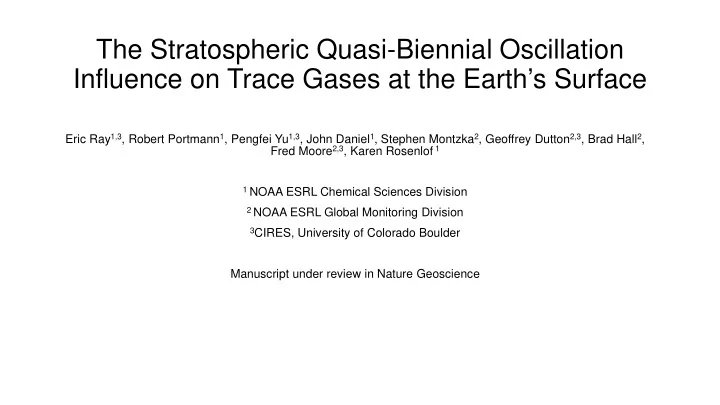

The Stratospheric Quasi-Biennial Oscillation Influence on Trace Gases at the Earth’s Surface Eric Ray 1,3 , Robert Portmann 1 , Pengfei Yu 1,3 , John Daniel 1 , Stephen Montzka 2 , Geoffrey Dutton 2,3 , Brad Hall 2 , Fred Moore 2,3 , Karen Rosenlof 1 1 NOAA ESRL Chemical Sciences Division 2 NOAA ESRL Global Monitoring Division 3 CIRES, University of Colorado Boulder Manuscript under review in Nature Geoscience
CFC-11 Global Average Growth Rates • Year over year changes • Seasonal cycle removed Focus here on the significant • Driven by emissions and 2-3 year variability throughout stratospheric transport the time series variability • Recent growth rate change driven by emission increase but quantification uncertain by up to 50% (Montzka et al., 2018) partly due to Projected transport.
CFC-11 Growth Rates • 2-3 year variability more apparent in individual site measurements • Phased differently in each hemisphere, generally larger amplitude in SH • Coherence suggests much of the variability is not noise • Can we attribute a cause or causes to the variability?
CFC-11 Growth Rates Examine 1-5 year variability by subtracting one year running mean (solid) from five year running mean (dashed)
Trace Gas Growth Rate Anomalies
Trace Gas Growth Rate Anomalies • Periods of coherent 2-3 year variability among these long-lived trace gases • Suggests stratospheric dynamical source
Stratospheric QBO as a Source of Surface Trace Gas Variability • The QBO is the most consistent interannual variability in the stratosphere. • Period of 2-3 years depending on pressure level. • How does the QBO affect the surface?
Average Stratospheric Transport and Trace Gas Loss Regions Stratospheric residual mean circulation (arrows) Variability in the loss of long-lived trace gases is primarily determined by transport. To understand how the QBO alters the average transport and trace gas loss we need to use a model…
Chemistry Climate Modeling • WACCM: high top version of Community Earth Systems Model (CESM) • CFC-11, CFC-12 and N 2 O included with emission boundary conditions (instead of fixed mixing ratio BC) • Emission time series based on smoothed observed global growth rates • Atmosphere model: free running except nudged “QBO” winds • Sea surface temperatures: climatology (1979-2018)
Model QBO Transport of CFC-11 Partial Pressure Anomalies Started by photochemical loss anomalies in the tropical and subtropical middle strat Tropical Zonal Wind Followed by advection into the extratropical lower strat and into the troposphere
Model Global Average CFC-11 Partial Pressure Anomalies
Model Global Average CFC-11 Partial Pressure Anomalies QBO winds (0 and -20 m/s) Every QBO cycle has an associated trace gas anomaly that propagates from the middle stratosphere to the surface over ~3 years
Model Global Average Surface Growth Rate Anomalies Consistent phase and similar amplitude of anomalies among these trace gases.
Global Average Surface Growth Rate Anomalies Amplitude of the QBO variability is similar in the model and measurements The model does not include all interannual stratospheric variability Difficult transport problem to simulate accurately
Model Derived Emission “Error” Due to QBO Difference between the emissions derived from the model global surface growth rates from the true input emissions. +/-5-15 Gg/yr for CFC-11 and CFC-12 +/-2-3 Tg/yr for N 2 O
Summary • The stratospheric QBO has a significant impact on the interannual variability of long-lived trace gases at the surface. • Accurately accounting for the QBO influence on tropospheric trace gases can substantially improve the accuracy of emission estimates on 1-5 year timescales. • Model results show the propagation of the trace gas anomalies from the stratosphere to the troposphere, but usually not with the correct timing. • More work needed to attribute surface interannual variability due ENSO, volcanoes, trends, etc.
Recommend
More recommend